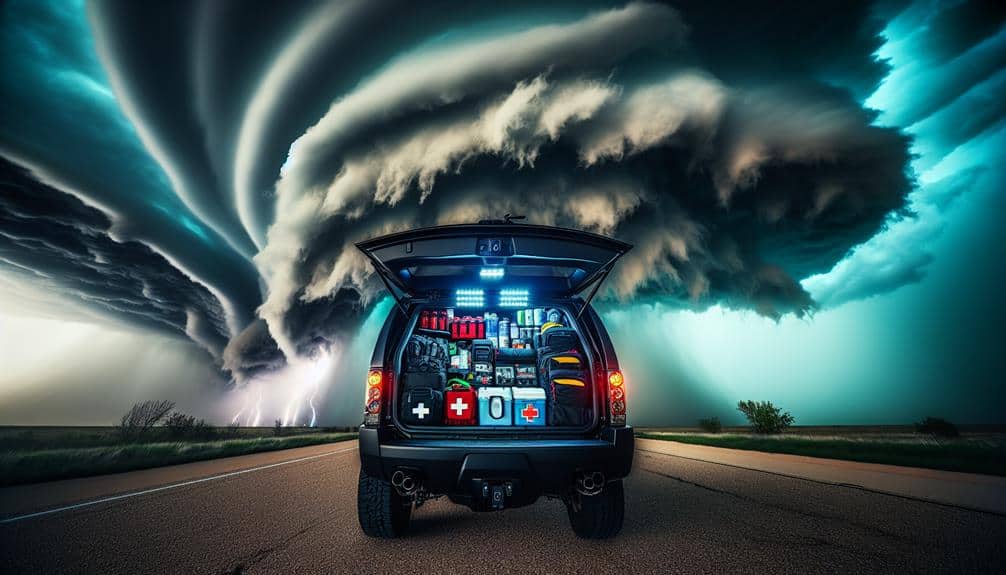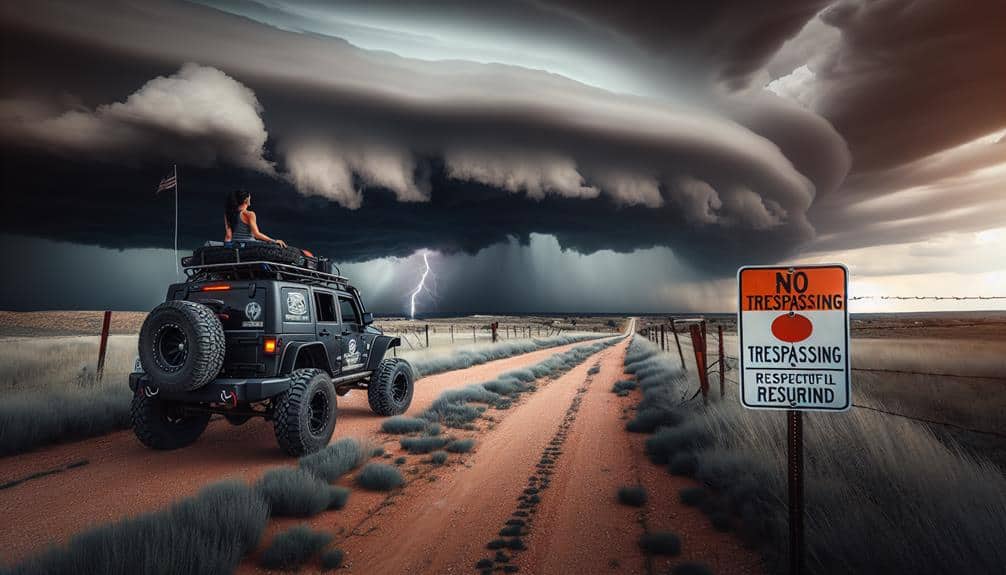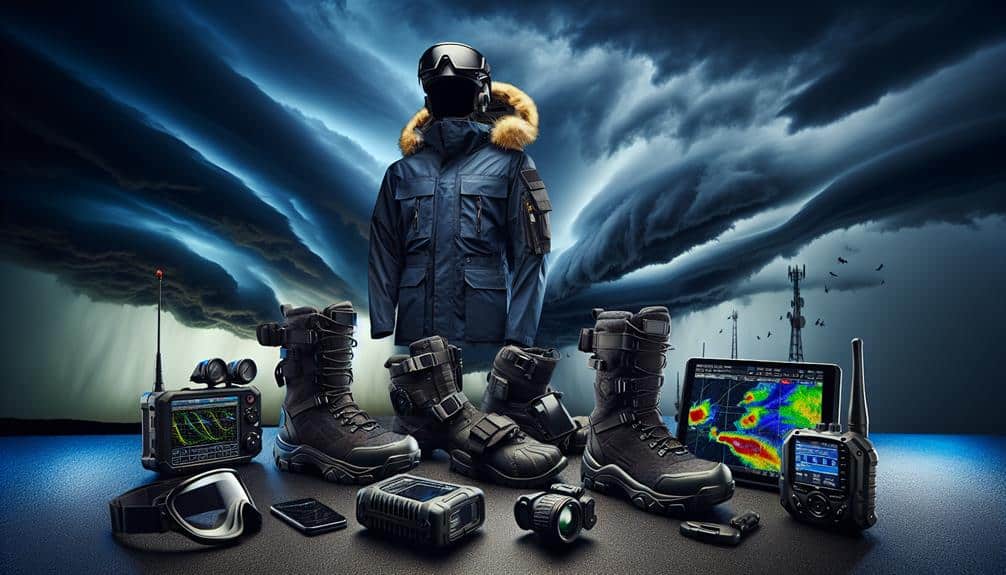As storm chasers, we must prioritize safety through continuous real-time weather updates and using advanced meteorological tools. Equipping ourselves with high-performance radar systems, GPS units, and conducting regular maintenance is critical. Planning routes based on updated meteorological data enhances our safety and efficiency. Effective communication strategies guarantee team coordination, while maintaining a safe distance from the storm's core helps avoid debris. Wearing protective gear and carrying emergency supplies is necessary. Analyzing historical weather data and understanding storm patterns aids our decision-making. Adhering to local laws and knowing when to retreat are essential. By following these measures, we can chase storms safely and effectively.
Key Points
- Continuously monitor real-time weather updates using advanced meteorological tools.
- Invest in high-performance, durable equipment and conduct regular maintenance checks.
- Plan routes using real-time data, avoiding dangerous and urban areas.
- Establish robust communication strategies with backup plans for team coordination.
Monitor Weather Updates
We must continuously monitor real-time weather updates to make data-driven decisions during storm chasing activities. Our ability to read and analyze weather patterns is essential for effective storm tracking. By leveraging advanced meteorological tools, we can predict storm paths and intensities with a higher degree of accuracy. This data-centric approach enables us to position ourselves strategically while minimizing risk.
Utilizing up-to-the-minute radar data, satellite imagery, and weather models, we can anticipate severe weather events and adjust our plans accordingly. These real-time updates provide crucial information that helps us to stay ahead of rapidly changing conditions. By integrating this data into our storm tracking efforts, we enhance our situational awareness and decision-making capabilities.
Emergency preparedness is another critical component of our strategy. We must establish and follow stringent safety protocols to protect ourselves and our teams. This includes having a clear evacuation plan, ensuring all members are aware of emergency procedures, and maintaining constant communication. By adhering to these protocols, we enhance our ability to respond swiftly and effectively to any unforeseen developments.
Use Reliable Equipment
To effectively leverage real-time weather updates, investing in reliable equipment is crucial for accurate data collection and safety. We need high-performance radar systems, GPS units, and anemometers to capture critical storm metrics. Our equipment must endure harsh conditions, making robust design essential. Equally important is equipment maintenance; regular checks guarantee everything functions at its best when it matters most.
Safety protocols aren't just recommendations—they're necessities. It's imperative our gear includes durable protective cases and secure mounts. We should always employ redundancies; for instance, carrying spare batteries and multiple data storage devices. These measures minimize the risk of equipment failure, thereby safeguarding our data and enhancing our safety.
Emergency communication is another cornerstone. Reliable two-way radios and satellite phones enable us to stay connected, even in areas devoid of cellular coverage. We should also establish backup plans, including pre-arranged check-in times and emergency rendezvous points. These protocols ensure swift action in case of unforeseen events.
Plan Your Route
When planning our route, we must continuously check real-time weather updates to anticipate storm movements.
By utilizing data from meteorological sources, we can map alternative routes to guarantee we avoid dangerous areas.
This approach not only maximizes our safety but also optimizes our storm-chasing efficiency.
Check Weather Updates
Monitoring real-time weather updates is vital for storm chasers to effectively plan their routes and secure safety. By staying informed, we can anticipate changes in weather patterns and implement appropriate emergency protocols. Utilizing advanced storm tracking tools guarantees we take necessary safety precautions without compromising our freedom to chase.
To keep ourselves updated, we should:
- Use dependable weather apps: These offer instant updates on storm developments.
- Monitor radar data: Accessing high-resolution radar images helps us track storm movements accurately.
- Follow meteorological services: The National Weather Service and other reputable organizations offer consistent updates.
- Set alerts: Real-time notifications for severe weather conditions keep us on our toes.
Analyzing live data allows us to adjust our plans dynamically. We need to interpret weather patterns meticulously to predict storm behavior and integrate emergency protocols efficiently. This proactive approach guarantees our safety precautions are responsive and effective.
Map Alternative Routes
Mapping different paths ensures we can swiftly navigate around obstacles and reach safe zones during storm chases. By planning our route meticulously, we minimize risks and maximize our ability to capture vital data. Alternate routes are necessary, as unexpected road closures or debris can block primary paths. This redundancy enhances our mobility, ensuring we don't find ourselves trapped in hazardous conditions.
Data analysis from previous chases reveals that having at least three alternate routes significantly enhances our chances of successful evacuation. Utilizing GPS technology, we can mark these routes in advance, integrating them into our navigation systems. This proactive measure is an important safety precaution, giving us multiple exits from any location.
In addition to alternate routes, it's important to familiarize ourselves with local evacuation procedures and identify emergency shelters en route. Knowing the nearest emergency shelters provides a fallback option if conditions worsen rapidly. It's also beneficial to establish communication protocols with local authorities, ensuring we receive timely updates on road conditions and safety advisories.
Communicate Regularly
Effective storm chasing necessitates that we communicate regularly to secure real-time updates and enhance team coordination. By implementing robust communication strategies, we can navigate safely and make informed decisions swiftly.
Establishing safety checkpoints guarantees everyone in the team remains accounted for and can respond rapidly to changing conditions. Consistent updates help us manage risks better, aligning our movements with emergency protocols.
To streamline our communication, consider these key strategies:
- Utilize GPS Tracking: Real-time location data allows us to monitor each other's positions and adjust routes as needed.
- Radio Communication: Reliable two-way radios guarantee we stay connected even in areas with poor mobile signal.
- Predefined Checkpoints: Setting up scheduled safety checkpoints helps us verify the safety and location of each team member.
- Use of Mobile Apps: Leveraging weather and communication apps provides instant access to critical updates and facilitates quick information sharing.
Stay in Safe Zones

When storm chasing, we must prioritize maintaining safe distances from the storm's core to mitigate risks.
Utilizing reliable equipment, such as radar systems and GPS, enhances our ability to track storm movements accurately.
Constantly monitoring weather updates guarantees we make informed decisions and adapt to changing conditions in real-time.
Maintain Safe Distances
Maintaining a safe distance from the storm's core is essential, as data indicates that the majority of storm-related injuries occur within close proximity to severe weather phenomena. Our primary objective is safe observation, which hinges on effective distance management. By staying outside the immediate danger zone, we reduce the risk of encountering hail, lightning, high winds, and tornadoes.
To implement proper distance management, let's consider these critical points:
- Utilize real-time weather data: Consistently monitor updates from reliable meteorological sources to keep track of the storm's path and intensity.
- Know your escape routes: Always have multiple exit strategies planned in case the storm changes direction or intensifies unexpectedly.
- Stay out of the core: Position ourselves at least a few miles away from the storm's core to avoid direct impacts.
- Use GPS tracking: Employ GPS devices to keep track of our location relative to the storm and adjust our position as necessary.
Use Reliable Equipment
Dependable equipment is essential for storm chasers, guaranteeing we can safely monitor and navigate severe weather conditions. Our first priority is to perform regular equipment maintenance and safety checks. This means examining our radar units, anemometers, and GPS devices before each chase. By keeping our gear in prime condition, we minimize the risk of malfunction during pivotal moments.
Relying on trusted gear and reputable brands is non-negotiable. High-quality equipment from brands like Davis Instruments and Garmin provides the accuracy and durability we need. For example, utilizing a Davis Vantage Pro2 weather station offers precise atmospheric readings, which are invaluable when tracking storm development. Similarly, Garmin GPS units ensure we can navigate even the most remote areas without losing our way.
We also need to take into account the effectiveness of our communication tools. Investing in robust two-way radios and satellite phones enhances our ability to stay connected, especially when cellular networks fail. This connectivity is vital for both coordination and emergency situations.
Monitor Weather Updates
Staying informed with real-time weather updates is necessary for guaranteeing we remain in safe zones during storm chases. By leveraging advanced weather tracking systems, we can anticipate changes in storm patterns and make informed decisions quickly. Our pursuit of freedom in storm chasing is grounded in our ability to analyze and respond to data in real-time.
Utilizing multiple sources for weather updates provides a thorough view of the storm's behavior. To enhance our safety and preparedness, let's focus on the following:
- Mobile Weather Apps: Platforms like RadarScope offer high-resolution radar data, which is essential for immediate risk assessment.
- NOAA Weather Radio: A reliable source for real-time broadcasts of warnings and alerts, crucial for understanding imminent threats.
- Satellite Imagery: Access to up-to-date satellite data helps us track storm evolution and potential escalation.
- Social Media Networks: Monitoring platforms like Twitter can provide real-time updates from fellow chasers and meteorologists.
Our commitment to meticulous weather tracking and adherence to emergency protocols not only maximizes our safety but also allows us to explore our passion for storm chasing with confidence and freedom.
Wear Protective Gear
Wearing protective gear, including helmets, goggles, and reinforced clothing, lowers the risk of injury during storm chasing activities. Data indicates that protective gear effectiveness can reduce injury rates by up to 70%. Helmets shield our heads from flying debris, while goggles prevent eye injuries from high-velocity winds and particles. Reinforced clothing, designed with materials like Kevlar, offers substantial defense against cuts and abrasions.
We don't have to compromise style for safety. The market now offers fashionable safety gear that integrates advanced protection features with modern aesthetics. Brands have developed sleek, aerodynamic helmets and customized goggles with anti-fog and UV protection. Reinforced jackets and pants come in various designs and colors, ensuring we stay safe without sacrificing our personal style.
Let's analyze the numbers: according to recent studies, storm chasers equipped with full protective gear experience notably fewer injuries. This data underscores the critical importance of investing in high-quality, well-designed gear. When we're out chasing thrilling weather phenomena, our gear becomes our first line of defense.
Keep Emergency Supplies

Let's make sure we've essential emergency supplies to reduce risks during our storm chasing ventures.
An essential first aid kit, reliable communication devices, and adequate sustenance and hydration supplies are non-negotiable.
Essential First Aid Kit
For effective storm chasing, we must make sure our first aid kit includes essential emergency supplies like bandages, antiseptics, and pain relievers. Proper first aid training and a well-stocked kit can significantly improve our emergency response capabilities and safeguard our safety in unpredictable conditions. Our kit should be thorough enough to address common injuries and medical issues we might encounter in the field.
Here's a list of key items our first aid kit should contain:
- Bandages and gauze: For wound care and bleeding control.
- Antiseptics: Essential for disinfecting cuts and preventing infections.
- Pain relievers: To manage pain from minor injuries and headaches.
- Tweezers and scissors: For removing debris and cutting medical tape.
Having these items not only supports our medical preparedness but also equips us with the survival skills needed in emergency situations. Data from storm chasing incidents underline the importance of being ready for both minor and severe injuries.
Reliable Communication Devices
In storm chasing, reliable communication devices are essential for maintaining contact with emergency services and fellow chasers, ensuring our safety and coordination in volatile weather conditions. Effective communication can mean the difference between a successful chase and a potentially life-threatening situation.
We rely on satellite phones for their robust signal reliability, even in areas where cellular networks fail. These devices guarantee our emergency contacts are always just a call away, providing an indispensable lifeline.
Walkie talkies, with their real-time communication capabilities, are another critical tool. They allow us to relay immediate weather updates and positional changes to our team, facilitating coordinated movements and swift responses. Integrating GPS tracking with our communication devices enhances our situational awareness.
Real-time location data enables us to navigate challenging terrains accurately, avoid hazardous zones, and maintain precise records of our movements.
When we combine these tools, we create a thorough communication network that bolsters our operational efficiency and safety. Whether it's through satellite phones for long-range communication or walkie talkies for immediate, team-specific updates, having the right devices ensures we're always connected.
This connectivity empowers us to chase storms with confidence and freedom, knowing our safety is prioritized.
Sustenance and Hydration Supplies
Maintaining sufficient nourishment and hydration supplies is crucial for storm chasers to secure peak physical and cognitive performance during extended chases. Without proper sustenance, we risk impaired judgment, slower reaction times, and reduced stamina—all critical factors in the high-stakes environment of storm chasing.
To optimize our readiness, we need to prioritize both food preservation and water purification. Non-perishable food items are invaluable for their longevity and ease of storage. Equally essential is access to clean water, which can be compromised during severe weather events. Implementing advanced water purification methods assures we stay hydrated without relying on potentially contaminated sources.
Our checklist for sustenance and hydration supplies should include:
- High-energy, non-perishable foods: Such as energy bars, nuts, and dried fruits for sustained energy.
- Portable water purification systems: To treat water from natural sources in case of emergency.
- Insulated coolers: For preserving perishable items during shorter trips.
- Electrolyte tablets or powders: To maintain electrolyte balance and prevent dehydration.
Understand Storm Patterns
Analyzing historical weather data and current atmospheric conditions is vital for accurately predicting storm patterns. We've got to dive deep into meteorological records and real-time data to understand how storm behavior evolves. By scrutinizing past weather patterns, we can identify recurring trends and anomalies that indicate potential storm development.
Let's look at key parameters: wind shear, atmospheric pressure, humidity, and temperature gradients. These variables interact in complex ways to influence storm behavior. For instance, high wind shear can disrupt storm formation, while sufficient moisture and unstable air often fuel severe storms. By studying these factors, we can make educated predictions about where and when storms are likely to form.
Accessing tools like Doppler radar, satellite imagery, and weather modeling software is essential. These technologies provide us with the real-time data needed to track storm systems and their trajectories. We must also stay updated with the latest forecasts from reputable sources such as the National Weather Service.
Follow Local Laws

While understanding storm patterns equips us with predictive capabilities, it's equally important to adhere to local laws to safeguard our safety and avoid legal complications. As storm chasers, we must know local regulations and respect boundaries to secure that our activities don't interfere with emergency services or public safety. Staying informed and following rules can make our storm-chasing experience both exhilarating and responsible.
Here are essential steps to help us stay compliant:
- Check for Permits: Some regions may require specific permits for storm chasing activities. Guarantee we've the necessary documentation.
- Adhere to Road Closures: Pay attention to road closures and detours. Ignoring these can lead to dangerous situations and legal penalties.
- Respect Private Property: Trespassing on private property is illegal and can lead to significant fines or arrests. Always seek permission if necessary.
- Monitor Weather Alerts: Local authorities often issue weather alerts and warnings. Stay updated to avoid restricted areas.
Know When to Retreat
Recognizing the signs of escalating danger is fundamental for knowing when to retreat from a storm-chasing expedition. We must analyze meteorological data continuously, including radar signatures and real-time storm reports. When indicators like strong rotation, rapid intensification, or unexpected storm mergers occur, it's vital to reassess our position. By knowing our limits, we can make informed decisions to prioritize safety over thrill.
Effective retreat strategies rely on pre-established exit routes. We should always have multiple egress plans, mapped out using GPS and local topographical data. These routes must be free of obstacles like flooded roads or debris. It's essential to monitor changing conditions that could compromise these paths.
When conditions deteriorate beyond safe thresholds, seeking shelter becomes imperative. Storm shelters, reinforced buildings, or even substantial ditches can offer temporary refuge. We must never underestimate the power of severe weather; retreating at the right moment can be the difference between life and death.
In the pursuit of freedom and discovery, we must balance our passion with prudence. By knowing when to retreat and seek shelter, we safeguard our lives and guarantee we can chase another day.
Frequently Asked Questions
What Are the Legal Implications of Storm Chasing on Private Property?
Did you know that 65% of storm chasers face legal issues? Property rights are important; trespassing laws mean we can't enter private land without permission. It's necessary to respect these boundaries to avoid hefty fines and legal repercussions.
How Do I Find Experienced Storm Chasing Groups or Mentors?
We can find experienced mentors by joining local meteorology clubs or online forums. These groups often follow strict safety protocols, ensuring we learn from seasoned storm chasers and prioritize our safety while enjoying the freedom of the chase.
What Are the Risks of Storm Chasing With a Pet in the Vehicle?
Storm chasing with a pet in the vehicle poses significant risks including pet safety concerns and emergency protocols for pets. We must guarantee secure restraints, adequate ventilation, and emergency plans to protect our pets during unpredictable weather events.
How Can Storm Chasers Minimize Their Environmental Impact?
We can minimize our environmental impact by prioritizing environmental conservation and sustainability in storm chasing. Using fuel-efficient vehicles, reducing waste, and adhering to leave-no-trace principles guarantees we chase storms responsibly without compromising our freedom.
What Are the Psychological Effects of Storm Chasing on Enthusiasts?
The psychological effects of storm chasing can take an emotional toll on us. Coping strategies are vital for maintaining mental health, and robust support systems are essential to help enthusiasts manage stress and process their experiences effectively.


